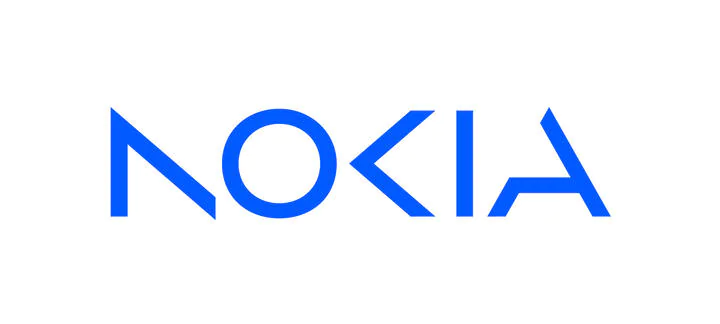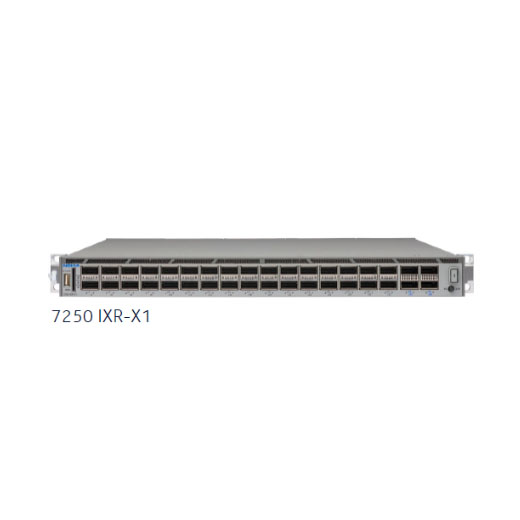Nokia 7250 IXR-X1
Interconnect Router
The Nokia 7250 IXR-X1 routers are ideal as leaf nodes in data centers and multi-access edge computing nodes and are valuable for access and aggregation as well as 5G interconnectivity.
Nokia 7250 X Series Product Family
Nokia 7250 Interconnect Router-X series (IXR-X series) routers1 are high-speed, high-density 1RU platforms. They are ideal as leaf nodes in data centers and multi-access edge computing nodes and are valuable for access and aggregation as well as 5G interconnectivity.
There are three platforms in the IXR-X series: the 7250 IXR-Xs, 7250 IXR-X1 and 7250 IXR-X3. Using these routers, network operators can efficiently scale up bandwidth to prepare for future growth requirements.
Features & Benefits
- Routers in the Nokia 7250 IXR-X series provide up to 14.4 Tb/s of system capacity and are equipped with high-performance 400GE, 100GE, 50GE, 40GE, 25GE and 10GE interfaces, allowing networks to scale to meet evolving traffic demands. At only 1RU high, these compact routers provide high port density while minimizing rack space. They consume low watts per gigabit, and therefore provide ongoing cost savings.
- The 7250 IXR-X series uses a common fixedform design with options for port interfaces, power supplies and airflow that provide the versatility needed to fit a wide variety of network requirements. Redundant fans improve resiliency. These routers are ideal for carrier data center applications where their flexible port interfaces support layers of aggregation, for example, a first leaf layer of 25GE to 100GE aggregation and a second layer of 100GE to 400GE aggregation. Optical breakout options provide high-density 25GE and 10GE port counts and flexibility to mix connector types and port speeds.
- The 7250 IXR-X series combines low nodal latency with advanced synchronization features to serve latency-sensitive applications and meet 4G and 5G fronthaul requirements. Advanced QoS features allow high-priority packets to traverse the network without queuing delay. This makes them ideal for centralized and virtualized RAN applications, BBU aggregation and edge computing applications.
-
the 7250 IXR-X platforms enable model-driven network management features through the Nokia SR OS and are managed by the Nokia Network Services Platform (NSP). The Nokia NSP offers a rich set of service management features that automate new service delivery and reduce operating costs.
Standards-based software-defined networking (SDN) interfaces enable best-path computation to be offloaded to path computation elements (PCEs) such as the Nokia NSP. The 7250 IXR operates as a path computation client (PCC), collecting and reporting per-link and per-service delay, jitter and loss metrics, as well as port utilization levels, for efficient path computation.
High-density aggregation
Diverse applications
Low latency and accurate synchronization
Automation
Software Features
- Point-to-point Ethernet pseudowires/virtual leased line (VLL)
- Ethernet Virtual Private Network (EVPN)
- Virtual Private Wire Service (EVPN-VPWS)
- Virtual Private LAN Services (EVPN-VPLS): IPv4 and IPv6 support, including Virtual Router Redundancy Protocol (VRRP)
- Multihoming with single/active or active/active modes
- Multipoint Ethernet VPN services with VPLS based on Targeted Label Distribution Protocol (T-LDP) and Border Gateway Protocol (BGP)
- Routed VPLS with Internet Enhanced Service (IES) or IP-VPN, IPv4 and IPv6
- Ingress and egress VLAN manipulation for Layer 2 services
- IP VPN Virtual Private Routed Network (VPRN), Inter-Autonomous System (Inter-AS) Option A, B and C
- IPv6 VPN Provider Edge (6VPE)
- Segment routing
- Intermediate System-to-Intermediate System (SR-IS-IS) and Open Shortest Path First (SR-OSPF)
- Traffic engineering (SR-TE) IPv4, IPv6
- MPLS label edge router (LER) and label switching router (LSR) functions
- Label Distribution Protocol (LDP)
- Resource Reservation Protocol with traffic engineering (RSVP-TE)
- IP routing
- Dual-stack Interior Gateway Protocol (IGP) – Multi-topology, multi-instance Intermediate System-to-Intermediate System (IS-IS)
– Multi-instance OSPF
– Multiprotocol BGP (MP-BGP)
– Accumulated IGP (AIGP) metric for BGP
– BGP monitoring protocol(BMP)
– BGP route-reflector for EVPN and IP-VPN with VPNv4 and VPNv6 address families (AFs)
– BGP confederations
– IGP and BGP shortcuts
Each product model supports, but is not limited to, a variation of the following features. Please refer to 7210 SAS technical documentation for the features supported on each product
Services
Network protocols
- Internet Group Management Protocol (IGMP)
- Multicast Listener Discovery (MLD)
- Protocol Independent Multicast – Sparse Mode (PIM-SM), Source Specific Multicast (SSM) for IPv4
- PIM-SSM for IPv6
- Next-generation multicast VPNs (NG-MVPN)
- SSM with multicast LDPv4 (mLDPv4)
- IGMP/MLD
- IGMP/MLD on routed VPLS interface
- PIMv4/PIMv6
- IGMP/MLD snooping
SDN
- PCC initialized, PCC controlled
- PCC initialized, PCE computed
- PCC initialized, PCE controlled
Load balancing and resiliency
- LDP with loop-free alternate (LFA) and remote loop-free alternate (rLFA) policies
- RSVP-TE
- Segment routing rLFA and topology independent LFA
Platform
QoS and traffic management
- Hierarchical egress schedulers and shapers per forwarding class, SAP, network interface, port or LAG
- Port sub-rate
System management
- NETCONF
- MD CLI
- Remote Procedure Call (gRPC)
- Port
- VLAN
- Filter output: Media Access Control (MAC), IPv4/IPv6 filters
- Local/remote
Security
- Forward and drop statistics, local/remote logging







